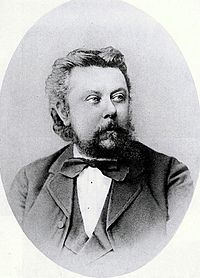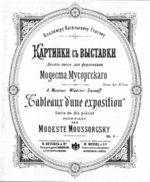Pictures at an Exhibition
Marlene’s Musings
November, 2012
As I study the score for Mussorgsky’s Pictures at an Exhibition, I am in awe of the creative genius of the composer, who wrote the piece for piano, and of the orchestrator, Maurice Ravel who transformed the piece for full orchestra. How does one take a brilliant piece written for piano and transform it into an orchestral masterpiece so perfect in color, character and variety?
For example, the very familiar opening Promenade is heard five times throughout the piece and represents the composer’s journey through an art gallery of works created by his friend, Victor Hartman. Could be boring to hear the same music five times, but on the contrary. Each repetition portrays a completely different mood. Ravel shortens or lengthens it, uses different instruments, changes keys, dynamics and tempi to create five completely different sounding iterations – proud, delicate, lumbering and tired, tranquil and finally triumphant.
For years I have played this piece and have met several saxophonists because or it. This work, along with precious few others, features the saxophone – BUT in only 1 of the 15 movements. We hear it in the movement entitled, The Old Castle. Hartman’s sketch evidently depicted a troubadour singing outside of a medieval castle. Once again, creative genius Ravel dreams up a brilliant idea and employs a rarely heard instrument with gorgeous, noble sound to portray this scene.
How do you musically portray a Polish ox-cart rolling along on enormous wheels? Ravel assigned the melody to the tuba! But, the part is written so much higher than in any other part of the piece. WHY? – Perhaps to put the figurative strain of the ox-cart onto the tuba player. It appears that, over the years, this strain has proved too much for tuba players because most often they bring a higher pitched instrument for this one solo. Many of us have heard it performed on the Euphonium – a beautiful instrument but the melody doesn’t have the strain of reaching for those extremely high, lip-busting notes!
There are movements that portray chicks popping out of their shells – high woodwinds, of course; There are women gossiping at a French market about a lost cow, false teeth and a drunken neighbor – lots of scurrying activity in upper strings and woodwinds; We hear a conversation between two Jewish men, one rich, one poor – brash, unison, slow, vibrato-rich strings for the rich bragger and a trumpet solo with an annoying, repetitive figure for the poor beggar. My favorite is The Hut on Fowl’s Legs, which is a musical portrayal of a day in the life of the Russian witch, Baba Yaga. She lives in a hut perched on hen’s legs and flies through the air in a black cauldron – the entire orchestra gets involved in chasing music to depict Baba Yaga as she lures her victims in.
In every movement there is magic! And I am the lucky one who gets to discover it every day!


